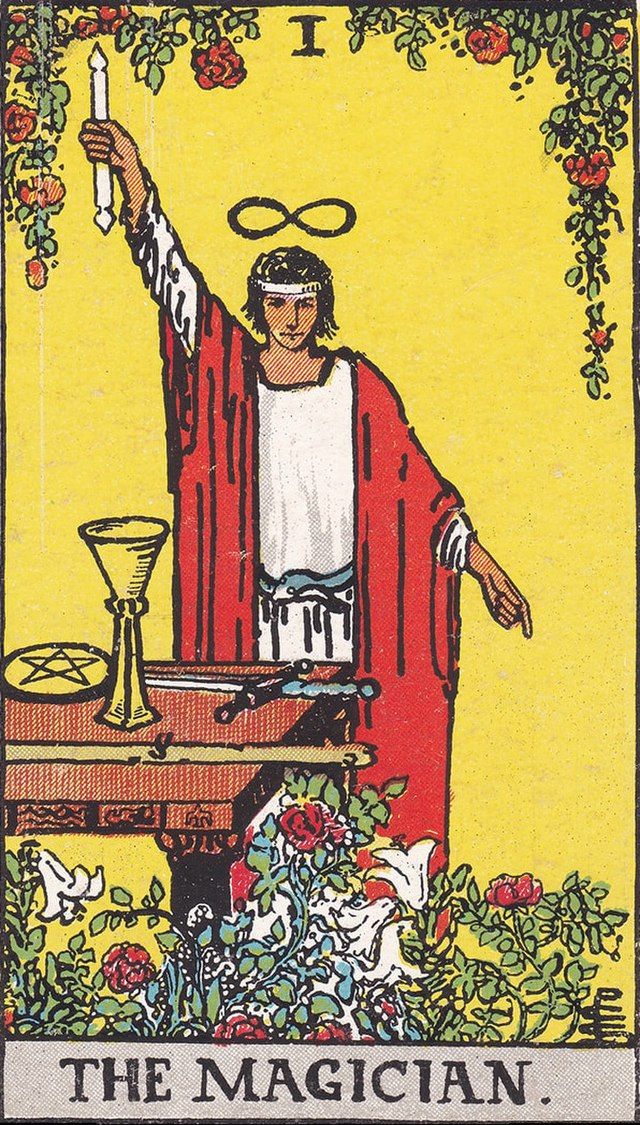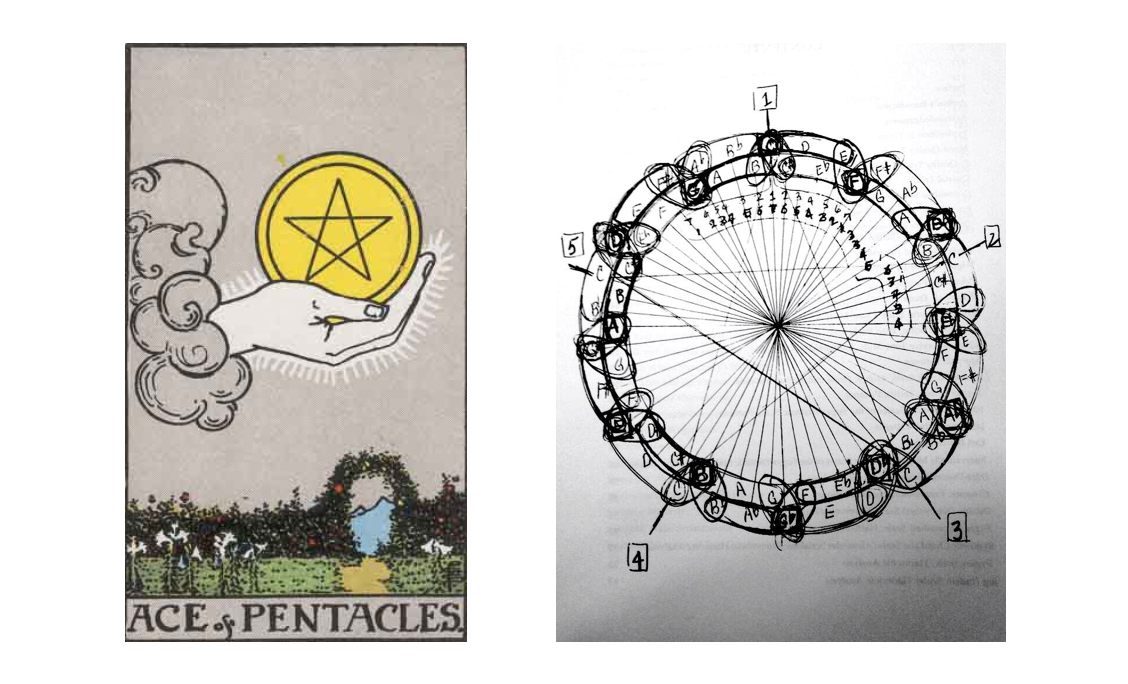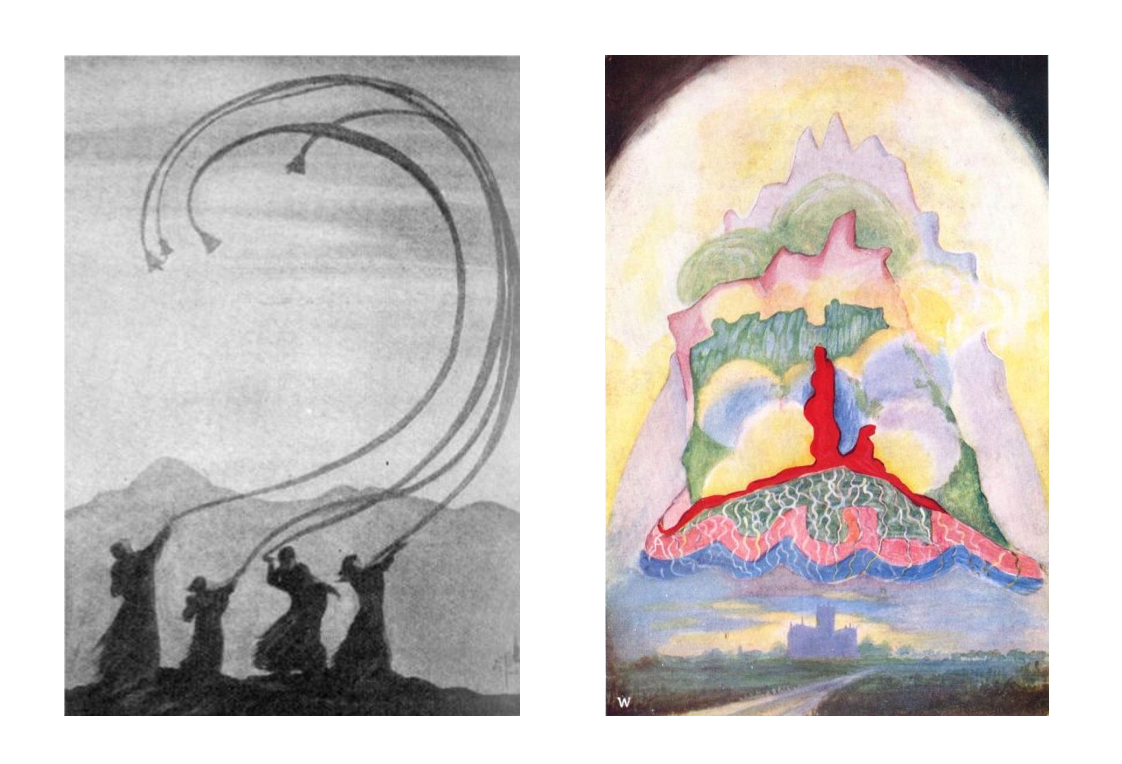Major Arcana in a Minor Key: the Symbolic Languages of Music and Tarot
Casper Lucia

“Overall, I think the main thing a musician would like to do is give a picture to the listener of the many wonderful things that he knows of and senses in the universe. . .”
– John Coltrane
"When I take a brush in hand and the music begins, it is like unlocking the door into a beautiful country.”
– Pamela Colman Smith

The Libra full moon is out tonight. A pale yellow ghost in the sky with a halo of soft light surrounding its face. Sitting on an old quilt in the pink glow of my bedroom, I ask the tarot cards what I should do about writing this piece. I can’t quite find the shape of it yet. As I’m shuffling, three cards jumble in my hands and end up in the middle of the deck facing the opposite direction as all the rest: TEMPERANCE, TEN of PENTACLES, and STRENGTH. Patience, abundance, trust… don’t rush, you have what you need, trust the process. I think about how these qualities relate to music – the inherent patience required by a time-based art form, an endless abundance of sounds, tones, textures, and that expansive trust in the universe that music at its best evokes.
Pamela “Pixie” Colman Smith, was an artist, writer, and occultist who in the early 20th century illustrated the iconic Rider-Waite-Smith Tarot deck. She was underpaid and under-recognized for her monumental, beautiful, and esoteric work, which has been a touchstone for generations of tarot readers, spiritual seekers, and artists. The imagery in the deck is nothing less than a complete symbolic language in itself. She also had synesthesia - “a neurological condition in which information meant to stimulate one of your senses stimulates several of your senses.” If the brain is a house, synesthesia opens doors that would otherwise be closed, and the inhabitants in various rooms can interact with each other freely. For example, in Colman Smith’s case, when she listened to music she also saw colors, shapes and images, and could translate these extrasensory perceptions into paintings.

“As the mind explores the symbol, it is led to ideas beyond the grasp of reason. The wheel may lead our thoughts toward the concept of a ‘divine’ sun, but at this point reason must admit its incompetence; man is unable to define a ‘diving’ being. When with all our intellectual limitations, we call something ‘divine,’ we have merely given it a name…”
– Carl Jung, Man and His Symbols
What I mean by ‘symbolic language’ is that the images the cards contain hold meanings that lie beyond what we can explore intellectually. Listening to "Giant Steps," I’m not trying to figure out what Coltrane’s modulations mean. I can’t reason my way through them. But the song makes me feel… playful, curious… reminds me of… riding a carousel, sun sparkling off falling water…
… and what transforms these symbols into a language is that these images & sounds in relationship to each other create new meanings, like words in a sentence. Like notes on a scale, what you hear is dependent on what surrounds it. Melody, harmony, polyphony, cacophony, it’s all a matter of context (and possibly, mathematics).
I wonder if Pamela Colman Smith was listening to music while she painted the tarot cards, and if she was, what that music was. It only makes sense to me that something so expansive could have originated with hearing: a sense door that, as opposed to sight, we have a lot less control over our input from and is primarily receptive as instead of directive.
“The Moon card is about the unknown forces that lay outside this physical realm and how we cope despite feeling like we’re losing control…”
– Noelia Tejada for The Collective Tarot
Who’s to say the wolves howling at the moon are compelled solely by biological imperative? Perhaps instinct in its own way shepherds us symbolically, calling us to where we feel we need to be, without knowing why, without reason. To grossly simplify what you could call a huge part of his life’s work, Jung would argue that symbols are what connect us to that other world beyond the veil, the collective unconscious, etc. The howl of those wolves becomes a kind of symbol for the human creatures hearing it… and we make music that tries to replicate what we heard in that howl, on that cold clear night… and that music makes us feel mournful, reminds us of the moon’s reflection in water, on another, cold, clear night.
The word symbol derives from the Latin symbolum - a symbol of faith - and symbolus - a sign of recognition. Faith and recognition… to me these are qualities that define the tarot. A faith in mystery, in a process that resonates but can’t be explained, and recognition of oneself and one’s world in the cards and the story they tell.
“I could compare my music to white light, which contains all colors,
only a prism can divide the colors and make them appear;
the prism could be the spirit of the listener.”
– Arvö Part
The relationship between music and listener, tarot cards and reader, symbol and consciousness, is what creates meaning. The vibration of strings on a guitar becomes a chord, becomes a feeling of yearning, an image of sunlight reflecting off the sea. A painting of a man at a table on which lies a cup, wand, sword, and pentacle, becomes a magician, becomes the essence of potential, transformation, manifestation. These relationships never take place in a vacuum; they are collective processes. When we are truly present with music and with tarot - or any sort of creative, reflective or divinatory practice - we are connecting with what is deep within and far beyond us. We can do this in small, playful, and organic ways. We don’t need a temple or a church or even a table or a chair. These tools are always at our disposal. They are portals to somewhere else – calling us to return to a place we’ve never been before.
in silence
you know that
every symbol holds an ancient flag
look at the cards
the Magician’s table is cluttered
he speaks a quiet so loud it glows
o, before the world there was the word
and before the word there was a stick
the trees gather around like a fire